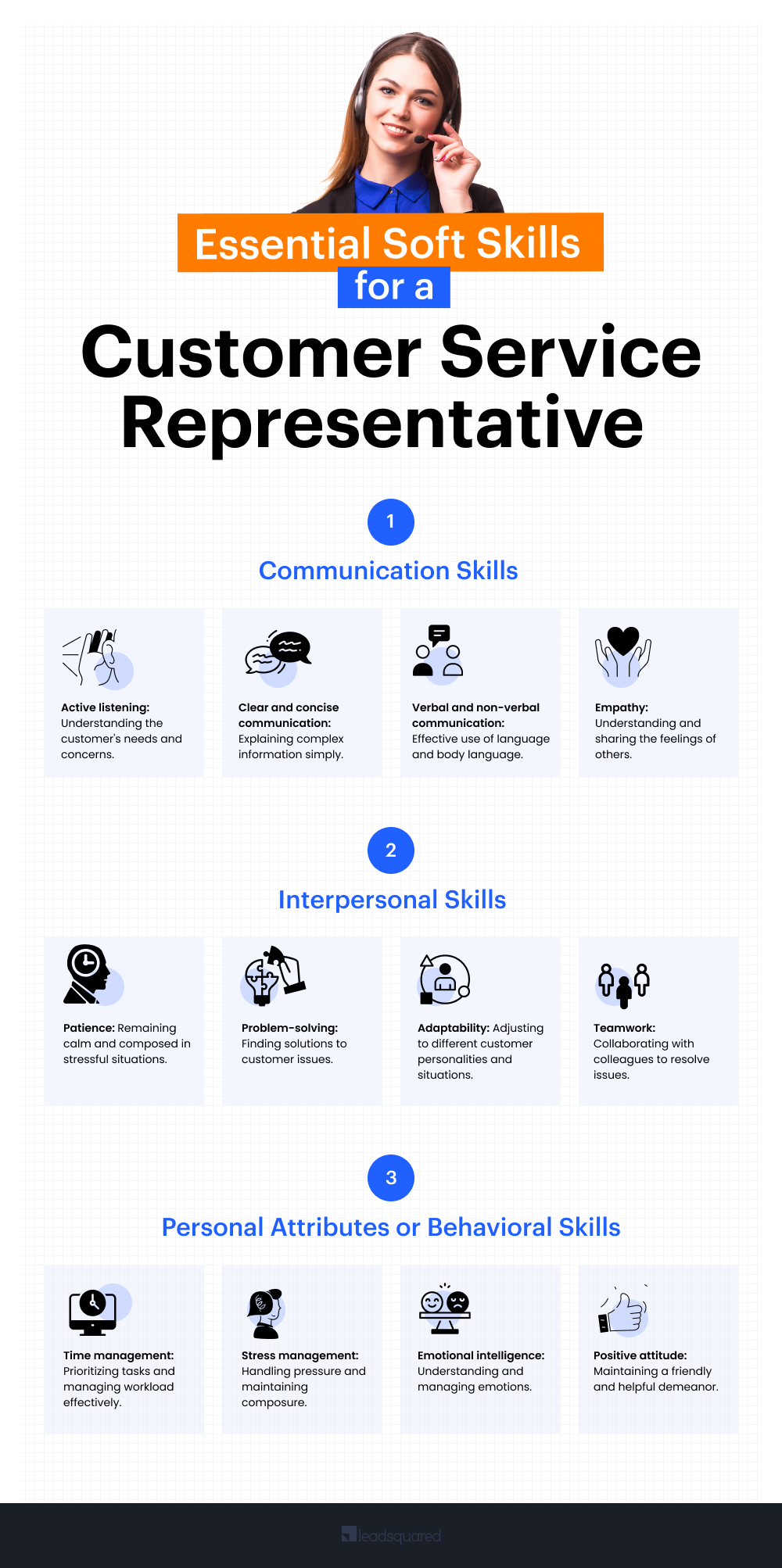Service reps must hone the following 12 essential soft skills to resolve queries faster and deliver positive customer experiences every single time.

We will delve deeper into each of these soft skills for customer service reps in the subsequent sections.
Communication Skills

1. Active listening
Active listening goes beyond just hearing what the customer is saying; it’s about understanding their perspective, emotions, and underlying needs. It’s about being fully present in the conversation, being empathetic, and responding thoughtfully.
This soft skill helps service reps build trust and avoid misunderstandings or the need for repeated explanations. The customer also feels heard and valued.
Follow these tips to get better at active listening.
- Pay attention: Focus on the speaker, maintain eye contact, and avoid distractions. Be genuinely interested in what the customer is saying.
- Decode verbal and non-verbal cues: Listen to the tone of voice, pace of speech, and word choice. Observe body language, facial expressions, and gestures to understand the customer’s emotional state.
- Paraphrase: Restate the customer’s message in your own words to confirm understanding. For example, “So, if I understand correctly, you’re saying that your order hasn’t arrived yet, and you’re concerned about the delivery date?”
- Reflect feelings: Acknowledge the customer’s emotions. For instance, “It sounds like you’re feeling frustrated about the situation.”
- Summarize: Recap the main points of the conversation to show you’ve been paying attention. “To summarize, you ordered a blue shirt but received a red one. You’re disappointed as it was a gift, and you need it for an event tomorrow.”
- Ask open-ended questions: Encourage the customer to elaborate by asking questions that require more than a “yes” or “no” answer. For example, “Can you tell me more about what happened when you tried to…”
- Empathise: Try to understand the customer’s perspective and feelings. Show you care about their situation and are willing to help.
- Silence: Allow the customer time to think and gather their thoughts without interrupting.
2. Clear and concise communication
Clear and simple communication is key to building trust and resolving customer issues quickly. It’s about communicating in a straightforward, easy-to-understand, and direct way.
The key elements of clear and concise communication include:
- Simplicity: Use plain language, avoiding jargon and technical terms.
- Brevity: Get to the point quickly without unnecessary details.
- Clarity: Structure your message logically and ensure it’s easy to follow.
- Active Voice: Use active voice for better clarity and engagement.
- Conciseness: Eliminate unnecessary words and phrases.
To communicate effectively with customers, tailor your message to the customer’s level of understanding. Give examples, or if you’re in a f2f or virtual meeting, use diagrams or flowcharts to add clarity. Ask the customer if they’ve understood the information and recap the main points to ensure your message is conveyed well.
Here’s an example of unclear vs clear and concise communication.
Unclear: “Due to unforeseen circumstances beyond our control, there has been a delay in the processing of your order, which is currently being expedited.”
Clear and Concise: “We apologize for the delay in processing your order. We’re working to ship it as soon as possible.”
3. Verbal and non-verbal communication
Customer service communication is a mix of what you say (verbal) and how you say it (non-verbal). Both components matter how your message is received.
The verbal communication involves:
- The tone of voice: This conveys emotions, attitudes, and sincerity. A warm, friendly tone builds rapport; a monotone or impatient tone can alienate customers.
- Word choice: Use clear, concise, and relevant language—no jargon or technical terms.
- The pace of speech: Speaking too fast can make it hard to understand, and speaking too slow can be boring. Find your comfortable pace.
- Enunciation: Articulate clearly so your message is heard.
Your facial expressions, eye contact with the customer while speaking, body language, and nodding while they are speaking add a statement to your communication. Also, respecting the customer’s personal space is an important aspect of non-verbal communication. Invasive body language could make them uncomfortable, so avoid that.
Make sure your verbal and nonverbal align. Inconsistencies can lead to confusion and mistrust. For example, saying “I’m happy to help” while looking bored or impatient will contradict your message.
4. Empathy
Empathy is the ability to understand and share the feelings of another person. In customer service, it’s about putting yourself in the customer’s shoes and feeling their emotions. It’s more than just sympathy; it’s about connecting with the customer on a deeper level.
To empathize with a frustrated customer, try:
- Active listening: Listen carefully to the customer’s message.
- Validate feelings: Acknowledge the customer’s emotions. e.g., “I understand you’re frustrated.”
- Use empathetic language: Use words that convey understanding and care. e.g., “I can see how disappointing this must be.”
- Offer support: Show the customer you’re there to help.
- Follow through: Keep your promises and follow up.
Interpersonal Skills

5. Patience
Patience is a key soft skill for customer service representatives. It’s the ability to stay calm, composed, and understanding, especially in tough or stressful situations.
It is an important soft skill for service reps because it shows you genuinely care for the customer and allows for calm problem-solving that helps resolve issues better.
Patience can be developed through practice. Follow deep breathing, mindfulness, and positive self-talking techniques to develop patience.
Customer service reps deal with a variety of customers every day. That also includes frequent encounters with difficult customers. The next question you may have is—how do you deal with difficult customers patiently?
To this, we would say,
- Listen carefully to the customer’s concerns (active listening).
- Acknowledge the customer’s emotions without judgment (validate their feelings).
- Clearly communicate what you can and can’t do (set boundaries).
- If needed, step away from the situation to regain composure.
6. Problem-solving
Problem-solving is a core competency for customer service representatives. It’s about identifying the root cause of the problem, developing solutions, and implementing the best course of action.
The problem-solving process involves the following steps:
- Define the problem: Clearly understand the customer’s issue.
- Gather information: Collect relevant details about the situation.
- Analyze the problem: Identify the root cause of the issue.
- Generate solutions: Brainstorm possible solutions.
- Evaluate options: Weigh the pros and cons of each solution.
- Implement the solution: Take action to resolve the problem.
- Follow-up: Ensure the problem is resolved and the customer is satisfied.
To solve customer problems, service reps must be critical thinkers who analyze information and make informed decisions. They should be able to think outside the box to find innovative solutions. Also, they should have decision-making capabilities and be able to choose the best course of action, such as involving supervisors or other departments as needed.
7. Adaptability
Adaptability is the ability to adjust to new situations and changes quickly. In customer service, it’s a crucial skill for handling unexpected customer inquiries, system glitches, or evolving company policies.
Being adaptable means being open to different ways of doing things and views, bouncing back from challenges and setbacks, finding creative solutions to unexpected issues, and managing emotions practically.
To develop adaptability in your personality,
- View change as an opportunity for growth.
- Challenge yourself to try new things.
- Believe in your ability to learn and improve.
- Understand different perspectives.
- Seek advice and support from colleagues.
This soft skill helps customer service reps find solutions or alternatives quickly, learn new systems, and remain calm and composed even under pressure.
8. Teamwork
Teamwork is the ability to work with others to achieve a common goal. In customer service, it’s about working with colleagues to fix customer issues, share knowledge, and improve overall performance.
What makes one a great sport?
- Communicates clearly with customers and collaborates well with peers
- Handles disagreements constructively
- Assists and encourages colleagues and teammates
Diverse perspectives lead to better solutions. That’s precisely the reason why teamwork yields better results. Further, team players tend to complete tasks faster and get to know the broader spectrum rather than focusing only on their core responsibilities.
Personal Attribute or Behavioral Skill

9. Time management
Time management is the art of effectively allocating time to tasks and activities. For customer service representatives, it’s crucial to handle a high volume of inquiries efficiently and provide excellent service.
To manage your time well while being productive,
- Prioritize tasks
- Allocate time blocks for different activities
- Delegate tasks wherever applicable
- Monitor how you spend time to identify areas of improvement
- Identify and eliminate time-consuming, unproductive activities
The truth is customer service reps have to handle high call volumes, manage interruptions, and juggle between multiple tasks. On top of that, the fact that so many reps are attending calls within the same premises makes the environment very distracting. Using tools like CRM systems and call queuing to optimize time could help here.
10. Stress management
Stress management is important for customer service reps who deal with difficult situations. It’s about applying techniques to manage stress and stay emotionally well.
Some of the common causes of stress in customer service are:
- High call volume
- Difficult customers
- Unrealistic expectations
- Tight deadlines
- System failures
To avoid burnout or negativity surrounding you, practice deep breathing, mindfulness and meditation, physical exercise, and eat a balanced diet. Not to mention sufficient sleep and frequent breaks to relax and regain composure.
11. Emotional intelligence
Emotional intelligence (EI) is the ability to understand and manage one’s own emotions, as well as recognize, understand, and influence the emotions of others. It’s a crucial soft skill for customer service representatives, as it directly impacts customer satisfaction and loyalty.
An emotionally strong service rep is:
- Self-aware: Understands one’s own emotions, strengths, weaknesses, drives, values, and how these impact others.
- Self-regulated: Can control or redirect disruptive impulses and moods.
- Empathetic: Understands the feelings of others and responds accordingly.
- Motivated: Has passion to pursue goals with energy and persistence.
Connecting with customers on an emotional level fosters trust and loyalty. Also, staying calm and composed under pressure diffuses tense situations.
To develop emotional intelligence, regularly assess your own emotions and behaviors. Pay attention to verbal and non-verbal cues and practice understanding and responding to others’ emotions. Finally, try various ways to manage stress and maintain emotional balance.
By developing emotional intelligence, customer service representatives can create more positive and lasting customer relationships.
12. Positive attitude
A positive attitude is more than just a smile; it’s a mindset that influences how you approach challenges, interact with others, and see the world. It’s a powerful tool in customer service as it can turn a bad situation into a good one.
A positive attitude is infectious and can lift a customer’s mood. It helps you think outside the box and find solutions. Plus, it can lift your team’s morale and give them the confidence to deal with another difficult customer or at least stay on the job.
To build a positive attitude,
- Focus on the good things in life and work.
- Be present and appreciate the small things.
- Identify negative thoughts when they come and focus on finding solutions.
- Challenge negative thoughts with positive affirmations.
- Surround yourself with positive people.
- Prioritize exercise, nutrition, and sleep.
A positive attitude is a choice. By consciously cultivating optimism, customer service representatives can create a more enjoyable and productive work environment, leading to increased customer satisfaction and overall job satisfaction.
In Conclusion
Soft skills are the foundation of great customer service. They turn transactions into connections. By developing these skills, customer service reps can not only fix issues but build relationships. Remember, every interaction is an opportunity to leave a good impression. Invest in your soft skills and watch your customer satisfaction rise.









